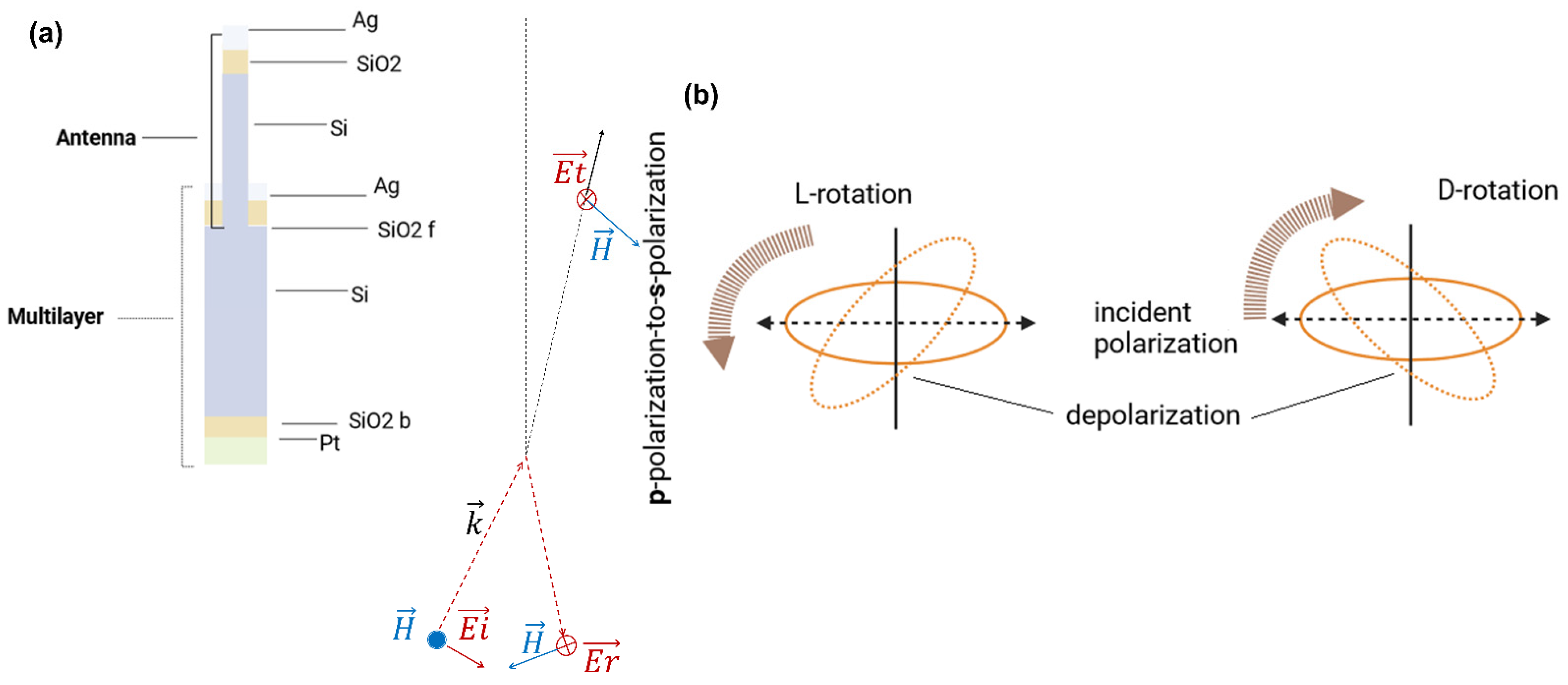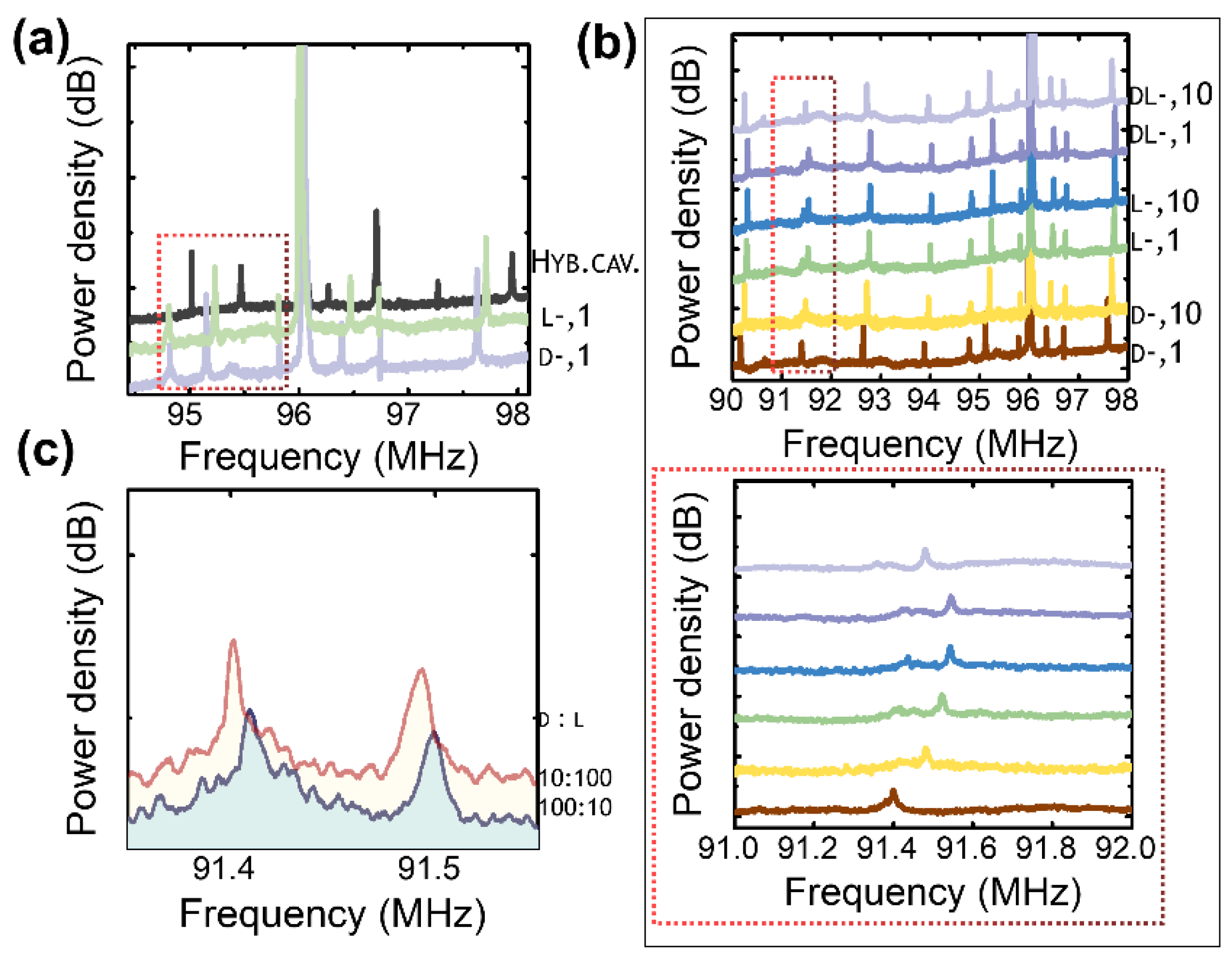Asymmetric Polarization in a Rough Multilayer: Towards the Discrimination of Enantiomer Pairs
Abstract
:1. Introduction
2. Rationale for Experiments
3. Results
3.1. Multilayer Plasmonic Response and Transmitted Signal
3.2. Discrimination of Enantiomers
4. Conclusions
Funding
Data Availability Statement
Conflicts of Interest
References
- Peluso, P.; Chankvetadze, B. Recognition in the Domain of Molecular Chirality: From Noncovalent Interactions to Separation of Enantiomers. Chem. Rev. 2022, 122, 13235–13400. [Google Scholar] [CrossRef] [PubMed]
- Biellmann, J.-F. Enantiomeric steroids: Synthesis, physical; biological properties. Rev. C 2003, 103, 2019–2033. [Google Scholar] [CrossRef]
- Waldeck, B. Biological significance of the enantiomeric purity of drugs. Chirality 1993, 5, 350–355. [Google Scholar] [CrossRef] [PubMed]
- Tang, Y.; Cohen, A.E. Enhanced Enantioselectivity in Excitation of Chiral Molecules by Superchiral Light. Science 2011, 332, 333–336. [Google Scholar] [CrossRef] [PubMed]
- Yang, L.; Kwan, C.-S.; Zhang, L.; Li, X.; Han, Y.; Leung, K.C.-F.; Yang, Y.; Huang, Z. Chiral Nanoparticle-Induced Enantioselective Amplification of Molecular Optical Activity. Adv. Funct. Mater. 2018, 29, 1807307. [Google Scholar] [CrossRef]
- Metzger, T.S.; Batchu, H.; Kumar, A.; Fedotov, D.A.; Goren, N.; Bhowmick, D.K.; Shioukhi, I.; Yochelis, S.; Schapiro, I.; Naaman, R.; et al. Optical Activity and Spin Polarization: The Surface Effect. J. Am. Chem. Soc. 2023, 145, 3972–3977. [Google Scholar] [CrossRef]
- Quan, M.; Pang, X.-Y.; Jiang, W. Circular Dichroism Based Chirality Sensing with Supramolecular Host–Guest Chemistry. Angew. Chem. 2022, 134, e202201258. [Google Scholar] [CrossRef]
- Stephens, P.J.; Devlin, F.J.; Cheeseman, J.R.; Frisch, M.J.; Bortolini, O.; Besse, P. Determination of absolute configuration using ab initio calculation of optical rotation. Chirality 2003, 15, S57–S64. [Google Scholar] [CrossRef]
- Wu, J.-L.; Wang, Y.; Su, S.-L.; Xia, Y.; Jiang, Y.; Song, J. Discrimination of enantiomers through quantum interference and quantum Zeno effect. Opt. Express 2020, 28, 33475–33489. [Google Scholar] [CrossRef] [PubMed]
- Lämmerhofer, M. Chiral recognition by enantioselective liquid chromatography: Mechanisms and modern chiral stationary phases. J. Chromatogr. A 2010, 1217, 814–856. [Google Scholar] [CrossRef]
- Pettinger, B.; Tadjeddine, A.; Kolb, D.M. Enhancement in Raman intensity by use of surface plasmons. Chem. Phys. Lett. 1979, 66, 544–548. [Google Scholar] [CrossRef]
- Hu, D.-B.; Chen, C.; Qi, Z.-M. Resonant Mirror Enhanced Raman Spectroscopy. J. Phys. Chem. C 2014, 118, 13099–13106. [Google Scholar] [CrossRef]
- Liu, L.; Li, X.; Nonaka, K. Light depolarization in off-specular reflection on submicro rough metal surfaces with imperfectly random roughness. Rev. Sci. Instrum. 2015, 86, 23107. [Google Scholar] [CrossRef] [PubMed]
- Goudonnet, J.P.; Inagaki, T.; Arakawa, E.T.; Ferrell, T.L. Angular and polarization dependence of surface-enhanced Raman scattering in attenuated-total-reflection geometry. Phys. Rev. B 1987, 36, 917–921. [Google Scholar] [CrossRef]
- Primeau, N.; Coutaz, J.L.; Abello, L. Effect of the metal film thickness on surface-plasmon-enhanced Raman scattering in an attenuated total reflection experiment. J. Appl. Phys. 1993, 73, 5158–5162. [Google Scholar] [CrossRef]
- Hizhnyakov, V.; Loot, A.; Azizabadi, S. Dynamical Casimir effect for surface plasmon polaritons. Phys. Lett. A 2015, 379, 501–505. [Google Scholar] [CrossRef]
- Kalachyova, Y.; Guselnikova, O.; Elashnikov, R.; Panov, I.; Žádný, J.; Církva, V.; Storch, J.; Sykora, J.; Zaruba, K.; Švorčík, V.; et al. Helicene-SPP-Based Chiral Plasmonic Hybrid Structure: Toward Direct Enantiomers SERS Discrimination. ACS Appl. Mater. Interfaces 2019, 11, 1555–1562. [Google Scholar] [CrossRef]
- Simone, G.; van de Donk, O. Oole Short chain thiols induce better plasmon resonance sensitivity in Au(111). J. Mater. Chem. C 2019, 7, 13803–13810. [Google Scholar] [CrossRef]
- Meyer, S.A.; Le Ru, E.C.; Etchegoin, P.G. Combining surface plasmon resonance (SPR) spectroscopy with surface-enhanced Raman scattering (SERS). Anal. Chem. 2011, 83, 2337–2344. [Google Scholar] [CrossRef]
- Simone, G.; de Ruijter, P. Plasmon resonance excitation enhances Raman emission and amplifies the molecular vibration on Au (111) film. Appl. Surf. Sci. 2020, 530, 147207. [Google Scholar] [CrossRef]
- Bahk, Y.-M.; Ramakrishnan, G.; Choi, J.; Song, H.; Choi, G.; Kim, Y.H.; Ahn, K.J.; Kim, D.-S.; Planken, P.C.M. Plasmon enhanced terahertz emission from single layer graphene. ACS Nano 2014, 8, 9089–9096. [Google Scholar] [CrossRef] [PubMed]
- Simone, G. Proof of enantioselectivity in a multilayer with a strong exciton polariton coupling and through asymmetric polarization. arXiv 2023, arXiv:2309.08979. [Google Scholar]
- Byun, K.M.; Kim, S.J.; Kim, D. Grating-coupled transmission-type surface plasmon resonance sensors based on dielectric and metallic gratings. Appl. Opt. 2007, 46, 5703–5708. [Google Scholar] [CrossRef] [PubMed]
- Yang, S.-L.; Yu, D.-M.; Liu, G.-D.; Lin, Q.; Zhai, X.; Wang, L.-L. Perfect Plasmon-Induced Absorption and Its Application for Multi-Switching in Simple Plasmonic System. Plasmonics 2018, 13, 1015–1020. [Google Scholar] [CrossRef]
- Kalas, B.; Ferencz, K.; Saftics, A.; Czigany, Z.; Fried, M.; Petrik, P. Bloch surface waves biosensing in the ultraviolet wavelength range—Bragg structure design for investigating protein adsorption by in situ Kretschmann-Raether ellipsometry. Appl. Surf. Sci. 2020, 536, 147869. [Google Scholar] [CrossRef]
- Lu, M.; Hong, L.; Liang, Y.; Charron, B.; Zhu, H.; Peng, W.; Masson, J.-F. Enhancement of Gold Nanoparticle Coupling with a 2D Plasmonic Crystal at High Incidence Angles. Anal. Chem. 2018, 90, 6683–6692. [Google Scholar] [CrossRef] [PubMed]
- Simone, G. Direct measurement of topological invariants in a double emitter system including plasmonic antennae. Optica Open Preprint 2024. [Google Scholar] [CrossRef]
- Zhang, S.; Huang, J.; Yu, Y.; Wang, S.; Yang, T.; Zhang, Z.; Tong, L.; Zhang, J. Quantum interference directed chiral raman scattering in two-dimensional enantiomers. Nat. Commun. 2022, 13, 1254. [Google Scholar] [CrossRef] [PubMed]
- Simone, G.; Abdalla, S. Ag/Au alloy entangled in a protein matrix: A plasmonic substrate coupling surface plasmons and molecular chirality. Appl. Surf. Sci. 2020, 526, 146711. [Google Scholar] [CrossRef]
- Hayat, A.; Mueller, J.P.B.; Capasso, F. Lateral chirality-sorting optical forces. Proc. Natl. Acad. Sci. USA 2015, 112, 13190–13194. [Google Scholar] [CrossRef]
- Sun, X.; Wang, N.; He, Y.; Kong, H.; Yang, H.; Liu, X. Molecule-specific vibration-based chiral differentiation of Raman spectra using cysteine modified gold nanoparticles: The cases of tyrosine and phenylalanine. J. Mater. Chem. B 2021, 9, 7167–7171. [Google Scholar] [CrossRef] [PubMed]
- Kong, H.; Sun, X.; Yang, L.; Liu, X.; Yang, H.; Jin, R.-H. Chirality Detection by Raman Spectroscopy: The Case of Enantioselective Interactions between Amino Acids and Polymer-Modified Chiral Silica. Anal. Chem. 2020, 92, 14292–14296. [Google Scholar] [CrossRef] [PubMed]






Disclaimer/Publisher’s Note: The statements, opinions and data contained in all publications are solely those of the individual author(s) and contributor(s) and not of MDPI and/or the editor(s). MDPI and/or the editor(s) disclaim responsibility for any injury to people or property resulting from any ideas, methods, instructions or products referred to in the content. |
© 2024 by the author. Licensee MDPI, Basel, Switzerland. This article is an open access article distributed under the terms and conditions of the Creative Commons Attribution (CC BY) license (https://creativecommons.org/licenses/by/4.0/).
Share and Cite
Simone, G. Asymmetric Polarization in a Rough Multilayer: Towards the Discrimination of Enantiomer Pairs. Nanomaterials 2024, 14, 1109. https://doi.org/10.3390/nano14131109
Simone G. Asymmetric Polarization in a Rough Multilayer: Towards the Discrimination of Enantiomer Pairs. Nanomaterials. 2024; 14(13):1109. https://doi.org/10.3390/nano14131109
Chicago/Turabian StyleSimone, Giuseppina. 2024. "Asymmetric Polarization in a Rough Multilayer: Towards the Discrimination of Enantiomer Pairs" Nanomaterials 14, no. 13: 1109. https://doi.org/10.3390/nano14131109



